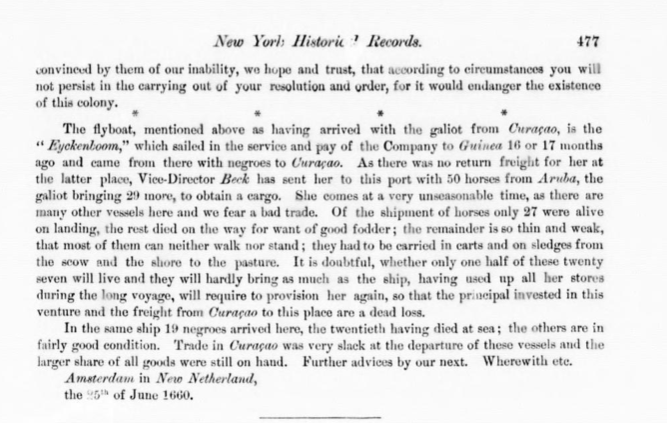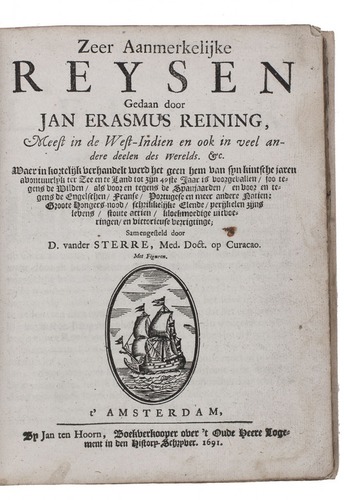In the era that Aruba was property of the WIC, from a history timeline perspective, it was quite unremarkable. That does not mean that nothing noteworthy happened. There is not much documentation to be found on these “forgotten” years. Nevertheless, here are some chapters in Aruba’s history worth telling. Even though one tends to forget, it is interesting to realise that during this Period The Dutch were at war with the Spanish, till 1648, the Portuguese and with the English. The latter was called the Anglo-Dutch wars of 1652-1654 and 1665-1667. In the end it resulted in the Dutch losing New Amsterdam (New York) to the English (but getting Surinam in return).
The first economic activity on Aruba – Export to New Amsterdam
Of the 3 islands, Curacao was the most important one. And Aruba was always under the shadow of its larger sister Island. Nevertheless, the Dutch WIC started breeding horses on Aruba, that they would export. Remarkably the first export of Aruban horses was to New Amsterdam, current New York. I say this, because for the past decades from the late 1980’s up to now, New York is still the number 1 source market for Aruba’s tourism industry.
The export endeavour was not successful though. There is not much of this history to be found. There is a report however, of a ship called “De Eyckenboom” that transported 20 slaves from Curacao and 50 horses from Aruba to New Amsterdam. Unfortunately half of the horses perished during the journey and the rest arrived to weak to even stand on their own feet. The original documentation, a letter from the Governor Peter Stuyvesant dated June 25 1660, mentioning this can be found HERE. Four years after the journey of “De Eyckenboom” the British captured New Amsterdam from the Dutch, and changed the name to New York.

Pirates of The Caribbean…..on Aruba
The Dutch were engaged in various wars, such as the Franco Dutch war and the 4 Anglo Dutch wars. During these periods there were many privateers or buccaneers, also known as pirates, roaming the sees between the Caribbean islands. These were seamen and sailors who would attack military and merchant vessels of a specific country with the blessing of another one (privateering). Jan Erasmus Reining, a Dutch buccaneer was one of them. He even served under the more famous Henry Morgan & Rock Brasiliano. Reyning’s visit to Aruba is documented. See it HERE on page 237. He landed on Aruba in 1677, fleeing from St. Maarten after being defeated by French Admiral Duc d’Estrées. His fame stems from the book: The Devils Anarchy; The very remarkable travels of Jan Erasmus Reyning, Buccaneer. Or as the book is called in Dutch: “Zeer aanmerkelijke reysen gedaan door Jan Erasmus Reyning”.

These visits from pirates have also found their way into Aruba’s folklore. I remember my grandmother telling me stories about fishermen seeing ghosts at night. These fishermen would tie up and hide their boats between mangroves or other vegetation on and near the beaches. Legend has it that there have been pirates who buried treasure on Aruba, and cut off the head of one of their crew and buried the body and head with the treasure to guard it. I don’t know if it is true, but I hope that someday someone does find treasure dating back to these years.
Aruba is still Spanish property…..or is it Dutch?
During the 80 years war with Spain, the Dutch captured Curacao, Aruba and Bonaire for their salt pans and strategic positions off the coast of the mainland. This happened without fierce battles or dramatic events. It happened so swiftly and quiet that the Spaniards did not realise they lost the Islands. Proof of this is the fact that it was not until almost 100 years later, that the then Spanish ambassador to the Dutch Republic, Vizconde de Herreria, asked an official status of specifically Aruba. The Dutch replied that they did not understand the fuss. Aruba has been theirs for a long time already. The original letter still exists in the archives of Simancas, Spain.
So the take-away on our Aruba roots here are:
- Aruba was property of the WIC and not really part of the Dutch “7 province republic”
- The population consisted of Arawak Indians that emigrated from the mainland & a few Europeans employed by the WIC
- Aruba was an “experimental” ranch for breeding goats and horses
- Aruba was spared much of the violence and battles of the many wars waging in that period
